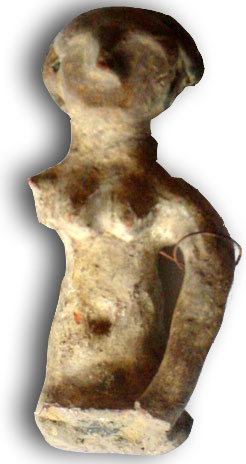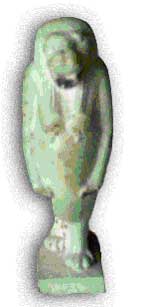|
 Inv.SD/SE/fe-87428 Inv.SD/SE/fe-87428
Bewitchment figurine
Egyptian bewitchment figurine dating from the Middle Empire
Found in the museum's reserve collection
 Description: Description:
Egyptian terracotta figurine representing the torso of a
woman (plant fibres and human hair).
In magic in general, and in Egyptian magic in particular, hair
is an object of power and control.
There are two theories about how this figurine was used.
The first suggests that the statuette was used for an
'amorous' bewitchment. In this case the human hair would come
from the person who benefits from the 'crime', since the victim
has been placed under the mental control of the sorcerer.
The second theory states that the hair comes from the victim,
in which case it could be used for any type of spell.
This matter is still under study, since the figurine is
linked to the presence of a Shade which haunts some of the rooms
at the Surnateum.
Other 'cursed' objects have been found in the same part of the
museum: a statuette of Taurt (the hippopotamus goddess) and a
small amulet of Heket, the frog-headed deity of childbirth.
|
|
 Inv.SD/SE/th-14047 Inv.SD/SE/th-14047
Statuette of the goddess Taurt
Egypt, 26th Dynasty
 Description: Description:
Statuette in green frit representing the goddess Taurt (the Great One).
This goddess represents the Great Eternal Mother, who is
depicted in the features of a female hippopotamus with a
crocodile tail and lion paws.
A symbol of fertility and an amulet for protecting pregnant
women, she is called "the mother who gives birth to all
gods".
The teeth, claws and points of the breasts have been removed
from this figurine in order to remove its evil powers.
|

